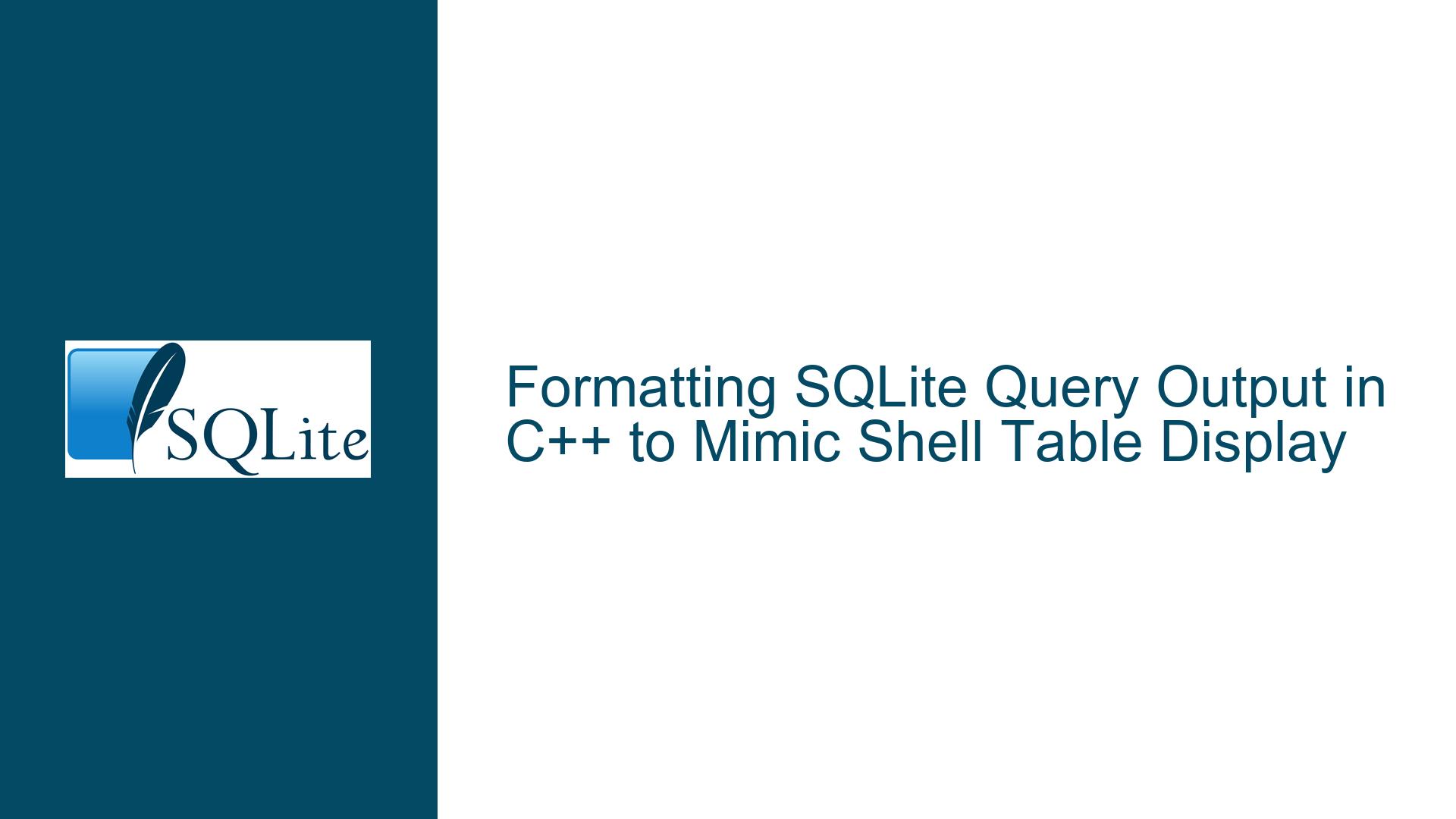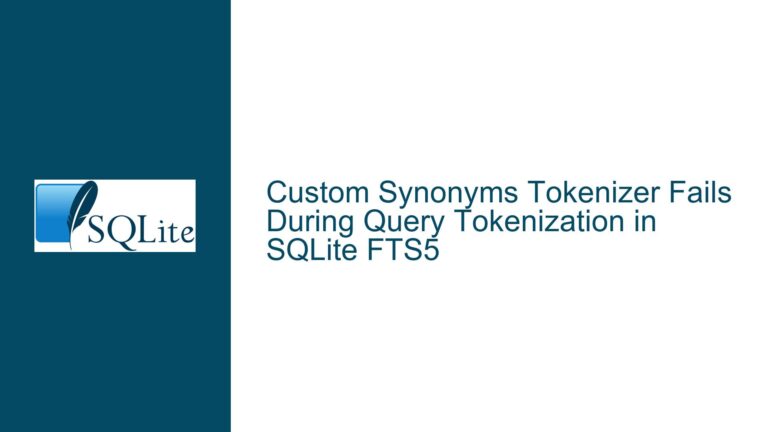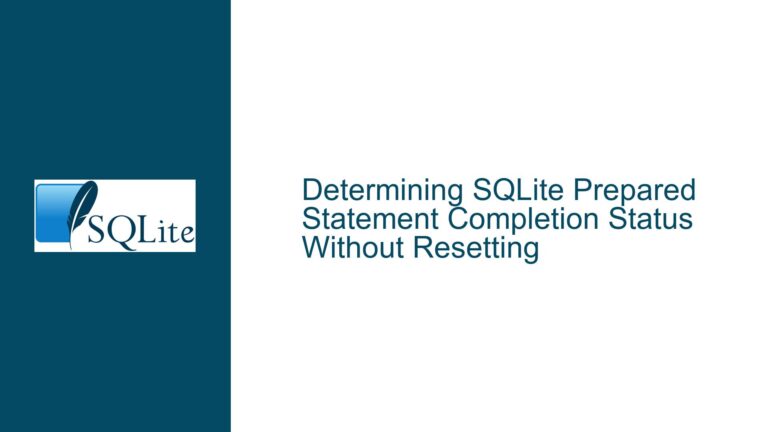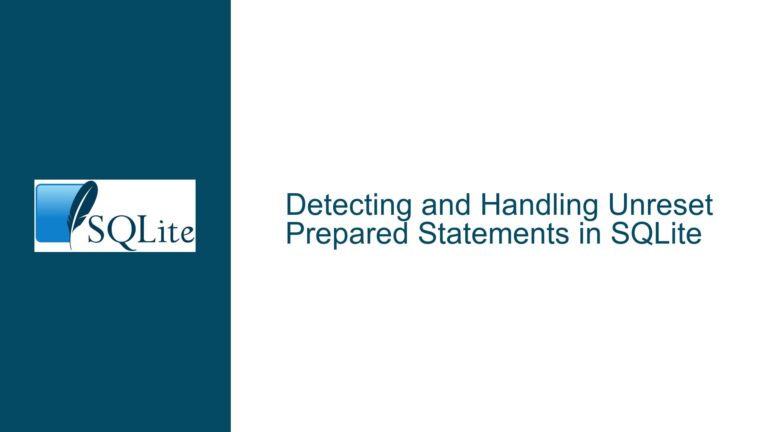Formatting SQLite Query Output in C++ to Mimic Shell Table Display
Understanding SQLite CLI Formatting Commands and C++ Integration Challenges
SQLite’s command-line interface (CLI) provides powerful formatting directives such as .mode table, .headers on, and .width to present query results in human-readable tabular layouts. These commands are indispensable for interactive debugging and data inspection. However, developers embedding SQLite within C++ applications often face difficulties replicating this formatted output programmatically. Unlike the CLI, the SQLite C/C++ API does not natively support these formatting directives, as they are implemented exclusively within the shell’s frontend logic. This disconnect forces C++ applications to either bypass the API’s raw data output or engineer custom solutions to achieve comparable visual fidelity. The core challenge lies in bridging the gap between the CLI’s user-friendly formatting layer and the low-level data retrieval mechanisms of the C++ API, all while maintaining performance and cross-platform compatibility.
Divergence Between CLI and API Responsibilities
The SQLite CLI (e.g., sqlite3.exe) acts as a middleware layer that interprets user commands, executes SQL operations via the C API, and post-processes results for display. Commands like .mode and .headers are CLI-specific and never reach the SQLite core library. When a C++ application uses sqlite3_exec() or sqlite3_prepare_v2(), it interacts directly with the database engine, retrieving raw result sets without formatting metadata. For instance, a SELECT * FROM tbl1 query executed via the API returns rows as arrays of strings or blobs, devoid of alignment, column width, or border decorations. This raw output is ideal for programmatic processing but inadequate for direct user presentation, necessitating manual intervention to replicate the CLI’s aesthetic enhancements.
Implications of Missing Formatting Directives in C++
The absence of built-in formatting support in the C++ API means developers must either:
- Reproduce the CLI’s formatting logic within their application, which requires parsing result sets, calculating column widths, and generating ASCII or Unicode table borders.
- Delegate formatting to the CLI by invoking it as a subprocess, redirecting input/output streams, and capturing its rendered output.
- Extract and integrate portions of the CLI’s source code (specifically
shell.c) into the C++ project, leveraging its existing formatting routines.
Each approach carries trade-offs in complexity, performance, and maintainability. For example, invoking the CLI as a subprocess introduces external dependencies and potential security risks, while reimplementing formatting logic increases codebase size and maintenance overhead.
Root Causes of Formatting Limitations in C++ SQLite Applications
1. CLI-Specific Command Architecture
SQLite’s .mode, .headers, and other dot-commands are parsed and executed entirely within the CLI’s shell.c source file. These commands configure internal state variables that dictate how query results are rendered. For example, .mode table activates a code path that wraps each row in ASCII border characters and aligns columns based on header widths. Since this logic resides outside the sqlite3 library, C++ applications cannot access it via standard API calls.
Example CLI Workflow:
- User inputs
.mode table→ CLI setsmodevariable toMODE_Table. - Subsequent
SELECTqueries pass throughshell.c’soutput_formatted()function, which applies borders and alignment. - Rendered text is sent to
stdout.
In contrast, a C++ app using sqlite3_exec() receives raw data through its callback function, with no hooks into the CLI’s formatting pipeline.
2. Lack of Metadata in SQLite API Results
The SQLite C API returns query results as arrays of column values, accompanied by basic type information (e.g., SQLITE_INTEGER, SQLITE_TEXT). However, it does not provide metadata critical for formatting, such as:
- Maximum column width for alignment.
- Header names (unless explicitly queried via
sqlite3_column_name()). - Row delimiters or border styles.
Developers must manually track this metadata by iterating through result sets twice: first to calculate column widths and header lengths, then to print formatted rows. This dual-pass approach introduces computational overhead, especially for large datasets.
3. Platform-Specific Terminal Handling
The CLI’s formatting logic assumes output is directed to a terminal capable of rendering fixed-width characters. C++ applications running in non-terminal environments (e.g., GUI apps, embedded systems) may lack APIs for querying terminal dimensions or adjusting text rendering. This can lead to formatting artifacts like truncated columns or misaligned borders when the application’s output medium differs from the CLI’s expectations.
Comprehensive Strategies for CLI-Like Table Formatting in C++
Solution 1: Invoke SQLite CLI as a Subprocess
Leverage the existing CLI’s formatting capabilities by executing it as a child process from your C++ application. This approach redirects input commands and output streams to/from the CLI, effectively outsourcing rendering tasks.
Step-by-Step Implementation:
Construct a Command String:
Combine formatting directives and SQL queries into a single input for the CLI.std::string query = ".mode table\n" ".headers on\n" "SELECT * FROM tbl1;\n" ".exit\n";Launch CLI as Subprocess:
Use platform-specific APIs to create a pipe, executesqlite3.exe, and redirectstdin/stdout.Unix-like Systems (Linux/macOS):
FILE* pipe = popen("sqlite3 your_database.db", "w"); if (!pipe) { /* Handle error */ } fprintf(pipe, "%s", query.c_str()); pclose(pipe);Windows:
SECURITY_ATTRIBUTES sa = { sizeof(SECURITY_ATTRIBUTES), NULL, TRUE }; HANDLE hWritePipe, hReadPipe; CreatePipe(&hReadPipe, &hWritePipe, &sa, 0); STARTUPINFO si = { sizeof(STARTUPINFO) }; si.dwFlags = STARTF_USESTDHANDLES; si.hStdOutput = GetStdHandle(STD_OUTPUT_HANDLE); si.hStdInput = hReadPipe; PROCESS_INFORMATION pi; CreateProcess(NULL, "sqlite3.exe your_database.db", NULL, NULL, TRUE, 0, NULL, NULL, &si, &pi); DWORD bytesWritten; WriteFile(hWritePipe, query.c_str(), query.size(), &bytesWritten, NULL); CloseHandle(hWritePipe); WaitForSingleObject(pi.hProcess, INFINITE);Capture and Display Output:
The CLI’s formatted output will be printed to the console automatically. For GUI apps, redirectstdoutto a buffer or file.
Pros:
- Minimal code changes; reuse battle-tested CLI formatting.
- Supports all CLI modes (e.g.,
box,markdown,csv).
Cons:
- Introduces dependency on
sqlite3executable. - Overhead from process creation and inter-process communication.
- Security risks if command strings include untrusted input.
Solution 2: Integrate Formatting Logic from SQLite’s Shell.c
SQLite’s CLI source code (shell.c) is public domain and can be modified/extracted to isolate formatting functions for use in C++ apps.
Implementation Steps:
Clone SQLite Source Repository:
git clone https://www.sqlite.org/src sqliteIdentify Relevant Functions in
shell.c:
Key functions include:output_formatted(): Entry point for rendering results based on.mode.print_box_row(): Generates table borders and aligns columns.compute_column_widths(): Calculates max widths for alignment.
Extract and Adapt Code:
Create a wrapper module that exposes these functions to your C++ app. Example:shell_formatter.h
#ifdef __cplusplus extern "C" { #endif void format_as_table(const char* dbPath, const char* query); #ifdef __cplusplus } #endifshell_formatter.c
#include "sqlite3.h" #include "shell.c" // Original CLI code void format_as_table(const char* dbPath, const char* query) { // Initialize global state from shell.c ShellState shellState; memset(&shellState, 0, sizeof(shellState)); shellState.mode = MODE_Table; shellState.showHeader = 1; // Open database sqlite3_open(dbPath, &shellState.db); // Execute query and format output shellState.out = stdout; shell_exec(&shellState, query); sqlite3_close(shellState.db); }Invoke from C++:
int main() { format_as_table("your_database.db", "SELECT * FROM tbl1;"); return 0; }
Pros:
- Achieves pixel-perfect CLI compatibility.
- No external process overhead.
Cons:
- Tight coupling with SQLite’s internal CLI code; may break with future updates.
- Requires deep understanding of
shell.c’s state management.
Solution 3: Custom Table Formatting in C++
For full control over output, implement a custom formatter within the C++ app. This involves querying column metadata, computing widths, and generating bordered text.
Implementation Steps:
Retrieve Column Metadata:
sqlite3_stmt* stmt; sqlite3_prepare_v2(db, "SELECT * FROM tbl1;", -1, &stmt, NULL); int colCount = sqlite3_column_count(stmt); std::vector<std::string> headers; std::vector<size_t> maxWidths(colCount, 0); // Get header names and initial widths for (int i = 0; i < colCount; ++i) { headers.push_back(sqlite3_column_name(stmt, i)); maxWidths[i] = headers[i].size(); }Compute Column Widths:
Iterate through all rows to determine maximum width per column.while (sqlite3_step(stmt) == SQLITE_ROW) { for (int i = 0; i < colCount; ++i) { const char* val = (const char*)sqlite3_column_text(stmt, i); size_t len = strlen(val); if (len > maxWidths[i]) maxWidths[i] = len; } } sqlite3_reset(stmt); // Rewind for data fetchingPrint Table Borders and Headers:
auto printBorder = [&]() { std::cout << "+"; for (size_t w : maxWidths) { std::cout << std::string(w + 2, '-') << "+"; } std::cout << "\n"; }; printBorder(); std::cout << "| "; for (int i = 0; i < colCount; ++i) { std::cout << std::left << std::setw(maxWidths[i]) << headers[i] << " | "; } std::cout << "\n"; printBorder();Print Rows with Alignment:
while (sqlite3_step(stmt) == SQLITE_ROW) { std::cout << "| "; for (int i = 0; i < colCount; ++i) { const char* val = (const char*)sqlite3_column_text(stmt, i); std::cout << std::setw(maxWidths[i]) << val << " | "; } std::cout << "\n"; } printBorder();
Pros:
- Full control over formatting, including custom borders and alignment.
- No external dependencies.
Cons:
- Increased code complexity.
- Requires handling edge cases (e.g., multi-line text, non-printable characters).
By systematically evaluating these strategies—subprocess invocation, CLI code integration, and custom formatting—developers can select the optimal balance between convenience, performance, and maintainability for their SQLite C++ applications.






